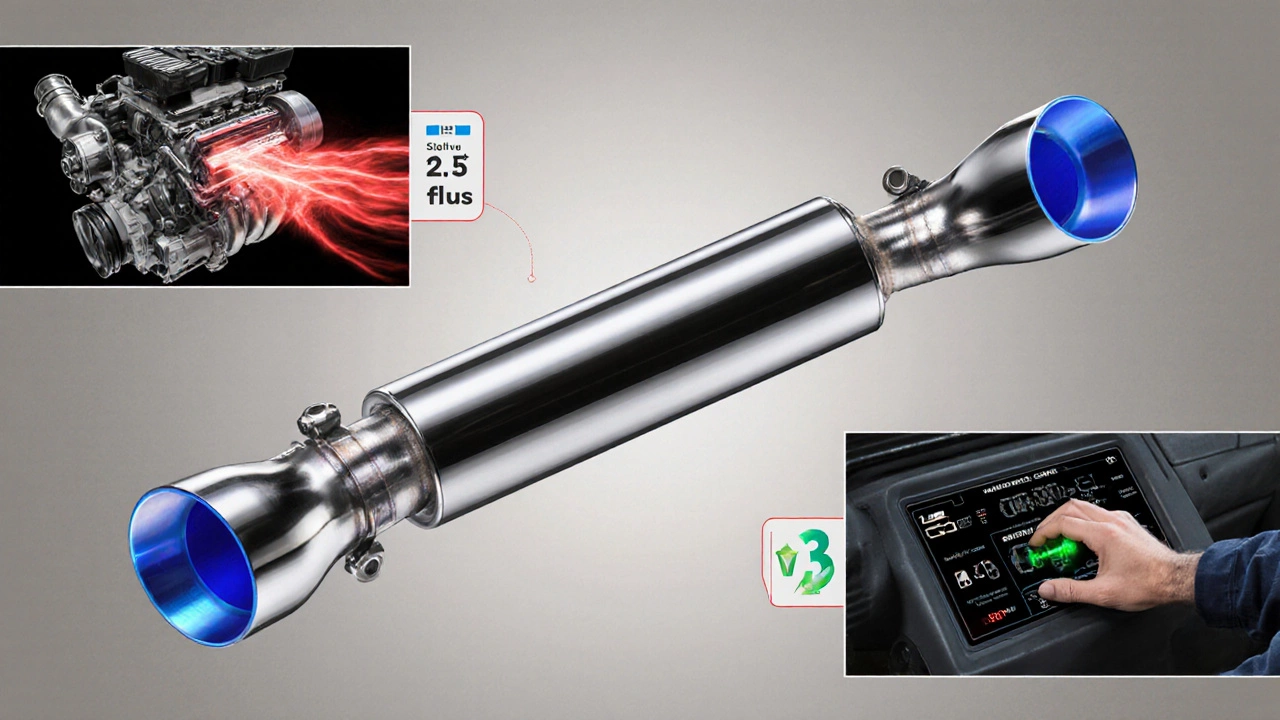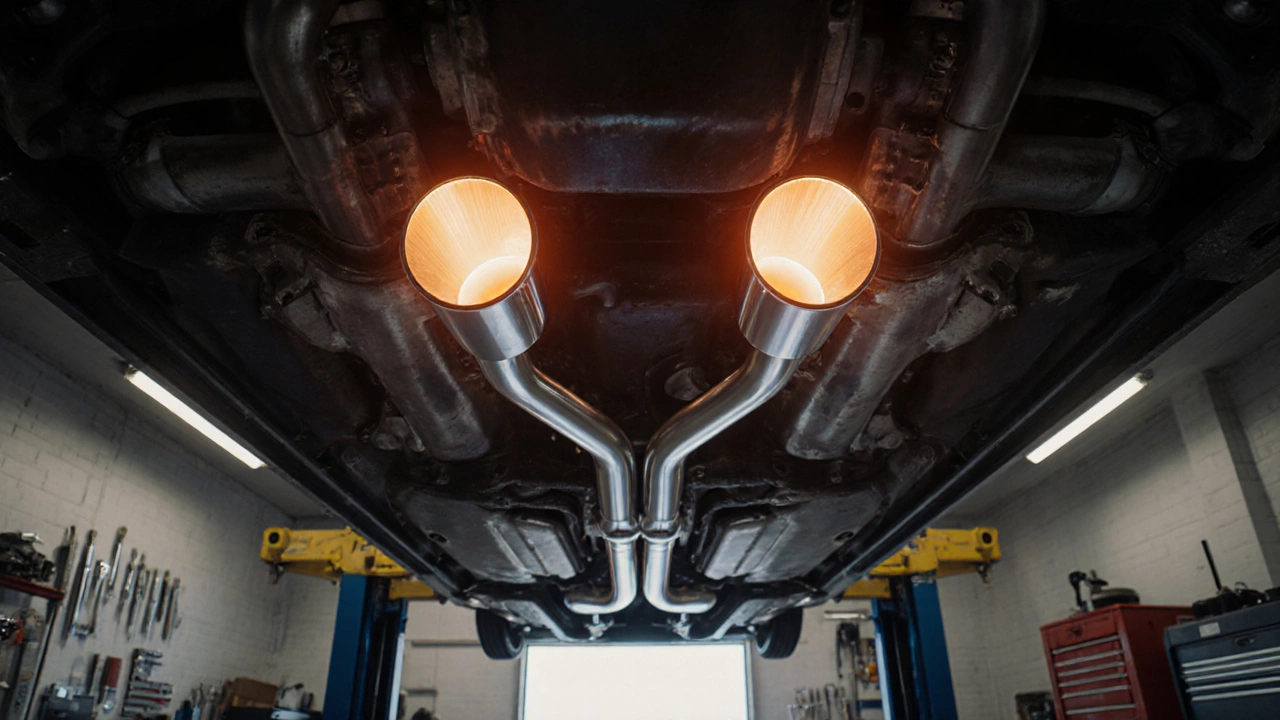2-into-1 Exhaust Power Gain Calculator
Estimate Your Power Gains
This calculator uses real dyno data from the article to estimate potential horsepower gains from a 2-into-1 exhaust system based on your engine configuration.
Estimated Horsepower Gain
This is an estimate based on real dyno testing data.
The actual gain depends on multiple factors including: Engine size Pipe diameter Exhaust manifold design Existing system restrictions
When you hear the term 2‑into‑1 exhaust is a pipe configuration that joins two separate exhaust streams into a single outlet before reaching the muffler or catalytic converter. The big question on every enthusiast’s mind is whether that setup actually adds horsepower gain or just sounds cooler. Let’s break down the science, look at real‑world numbers, and give you a clear idea of when a 2‑into‑1 makes sense for your car.
How a 2‑into‑1 Exhaust Works
Think of each engine cylinder as a tiny fan that pushes exhaust gases out of the combustion chamber. In a typical four‑cylinder engine you have four separate exhaust ports that travel to the manifold and then to the tailpipe. A 2‑into‑1 system pairs those ports into two groups, merges each pair with a collector, and then combines the two collectors into a single pipe.
- Collector merge: Two exhaust streams meet at a Y‑shaped junction.
- Scavenging effect: When the pressure wave from one cylinder travels down the pipe, it can help pull the next pulse out of the adjacent cylinder, improving flow.
- Reduced surface area: Fewer pipe walls mean slightly less friction as gases travel.
The idea is that by smoothing the path and encouraging better scavenging, the engine can breathe more freely, which could translate into a modest power bump.
Key Factors That Influence Power Gains
Even if the theory sounds solid, the actual result depends on many variables. Below are the most common ones that affect whether a 2‑into‑1 will add any real horsepower.
- Engine size and RPM range: High‑revving engines (like a 2.0‑liter turbo) benefit more from improved flow than low‑rev, torque‑heavy diesels.
- Exhaust manifold design: A well‑matched header that already promotes scavenging can make the 2‑into‑1’s contribution negligible.
- Pipe diameter: Too small a pipe chokes flow; too large can reduce exhaust velocity, hurting low‑end torque.
- Catalytic converter and muffler size: Restrictive cats or mufflers dominate back‑pressure; swapping the pipe alone won’t overcome that.
- Engine tuning: Fuel maps, ignition timing, and cam profiles need to be optimized to take advantage of any extra flow.
In short, the exhaust is just one piece of a bigger puzzle.
What Dyno Tests Actually Show
Several independent dyno studies have measured the effect of a 2‑into‑1 conversion on stock engines. Here are the most consistent findings:
- Stock 2.0‑liter naturally aspirated four‑cylinder: average gain of 2-4 hp (0.5-1 %).
- Turbocharged 1.6‑liter engine with factory cat‑back: gains up to 5-7 hp when the cat is replaced with a high‑flow unit.
- Large V8 with aggressive cam and free‑flowing intake: often less than 1 hp because the engine already breathes well.
Notice the pattern - the biggest improvements appear when the exhaust system was previously a bottleneck. If you already have a performance header and a low‑restriction cat, the 2‑into‑1 pipe adds very little.

Pros and Cons Checklist
| Pros | Cons |
|---|---|
| Potential modest horsepower gain (2-5 hp) on restrictive stock systems | Gain is often negligible on already‑free‑flowing setups |
| Cleaner look - fewer external pipes | Installation can be trickier; may require custom bends |
| Reduced weight compared to dual‑pipe systems | May increase back‑pressure if pipe diameter is too small |
| Improved exhaust note when paired with a high‑flow muffler | Does not replace the need for a high‑flow catalytic converter |
Installation Tips to Maximize Results
Even the best‑designed pipe won’t help if it’s installed wrong. Follow these steps:
- Start with a quality header that matches your engine’s firing order.
- Choose a pipe diameter that balances flow and velocity - 2.5" is common for four‑cylinders, 3" for six‑cylinders.
- Use mandrel‑bent sections to keep the internal surface smooth.
- Seal the Y‑junctions with high‑temperature silicone to prevent leaks.
- After installation, run a full tune (or at least a fuel‑trim check) to confirm the ECU sees the new flow.

When a 2‑into‑1 Is the Right Choice
Based on the data, here are the scenarios where you’ll actually notice a benefit:
- You drive a stock or mildly modified car with a restrictive factory cat‑back system.
- You’re looking for a modest power bump without spending a lot on a full cat‑back or turbo upgrade.
- You value a cleaner rear‑end appearance and a slight weight reduction.
If you’re already running a high‑flow header, performance cat, and tune, the 2‑into‑1 is more about aesthetics than gains.
Alternatives to Consider
If the goal is horsepower, there are other routes that often deliver bigger returns:
- High‑flow catalytic converter: Can shave 3-6 hp of back‑pressure.
- Cat‑back system: Replaces everything after the cat and can add 5-10 hp on many engines.
- Turbo or supercharger upgrade: Provides the biggest jump, but costs more.
- Engine tune: Simple ECU flash can unlock 5-15 hp if the engine is already well‑breathing.
Pairing a 2‑into‑1 with one of these upgrades can still be worthwhile, especially if you like the visual look.
Bottom Line
So, does a 2‑into‑1 exhaust increase horsepower? Yes - but only by a small amount, and usually only when the rest of the exhaust system is a bottleneck. Think of it as a subtle tweak rather than a major power‑boosting modification. If you’re after a clean look and a tiny performance edge on a stock car, it’s a sensible buy. For serious horsepower gains, focus on the cat, muffler, and tuning first.
Will a 2‑into‑1 exhaust make my car louder?
It can change the tone, especially if you pair it with a free‑flow muffler, but the volume increase is usually modest. The main effect is a deeper, smoother note rather than sheer loudness.
Do I need a new catalytic converter when I install a 2‑into‑1?
Not strictly, but a restrictive cat will limit any gains. For the best results, swap the factory cat for a high‑flow unit.
Can I install a 2‑into‑1 myself?
If you have basic hand‑tool skills and access to a lift, it’s doable. The trickiest part is getting the bends right and sealing the Y‑junctions properly.
How do I measure the horsepower gain?
A chassis dyno before and after the install is the most reliable method. Look for a net gain after accounting for fuel and temperature corrections.
Is a 2‑into‑1 legal for road use?
In the UK, as long as the system meets noise regulations and the cat remains functional, it’s road‑legal. Always check local MOT rules.

